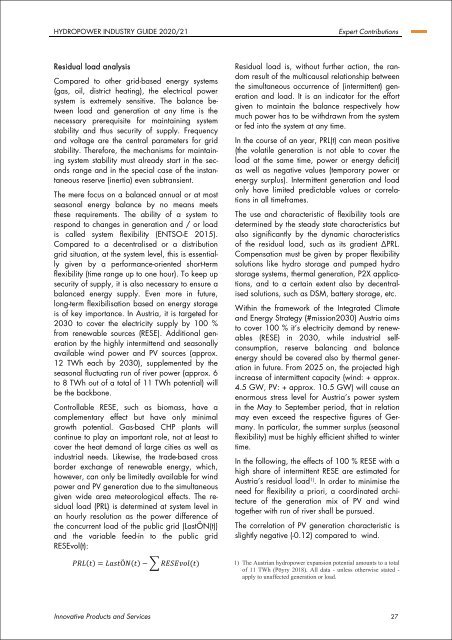VGB PowerTech | Hydro - Hydropower Industry Guide 2020/21
Innovative products and services from operators, suppliers, manufacturers and consultants and a lot of sector information. 1st issue. Final version 2020/21 View online and download on demand!
Innovative products and services from operators, suppliers, manufacturers and consultants and a lot of sector information.
1st issue. Final version 2020/21
View online and download on demand!
You also want an ePaper? Increase the reach of your titles
YUMPU automatically turns print PDFs into web optimized ePapers that Google loves.
HYDROPOWER INDUSTRY GUIDE <strong>2020</strong>/<strong>21</strong><br />
Expert Contributions<br />
Residual load analysis<br />
Compared to other grid-based energy systems<br />
(gas, oil, district heating), the electrical power<br />
system is extremely sensitive. The balance between<br />
load and generation at any time is the<br />
necessary prerequisite for maintaining system<br />
stability and thus security of supply. Frequency<br />
and voltage are the central parameters for grid<br />
stability. Therefore, the mechanisms for maintaining<br />
system stability must already start in the seconds<br />
range and in the special case of the instantaneous<br />
reserve (inertia) even subtransient.<br />
The mere focus on a balanced annual or at most<br />
seasonal energy balance by no means meets<br />
these requirements. The ability of a system to<br />
respond to changes in generation and / or load<br />
is called system flexibility (ENTSO-E 2015).<br />
Compared to a decentralised or a distribution<br />
grid situation, at the system level, this is essentially<br />
given by a performance-oriented short-term<br />
flexibility (time range up to one hour). To keep up<br />
security of supply, it is also necessary to ensure a<br />
balanced energy supply. Even more in future,<br />
long-term flexibilisation based on energy storage<br />
is of key importance. In Austria, it is targeted for<br />
2030 to cover the electricity supply by 100 %<br />
from renewable sources (RESE). Additional generation<br />
by the highly intermittend and seasonally<br />
available wind power and PV sources (approx.<br />
12 TWh each by 2030), supplemented by the<br />
seasonal fluctuating run of river power (approx. 6<br />
to 8 TWh out of a total of 11 TWh potential) will<br />
be the backbone.<br />
Controllable RESE, such as biomass, have a<br />
complementary effect but have only minimal<br />
growth potential. Gas-based CHP plants will<br />
continue to play an important role, not at least to<br />
cover the heat demand of large cities as well as<br />
industrial needs. Likewise, the trade-based cross<br />
border exchange of renewable energy, which,<br />
however, can only be limitedly available for wind<br />
power and PV generation due to the simultaneous<br />
given wide area meteorological effects. The residual<br />
load (PRL) is determined at system level in<br />
an hourly resolution as the power difference of<br />
the concurrent load of the public grid (LastÖN(t))<br />
and the variable feed-in to the public grid<br />
RESEvol(t):<br />
PRLt LastÖNt RESEvolt<br />
Residual load is, without further action, the random<br />
result of the multicausal relationship between<br />
the simultaneous occurrence of (intermittent) generation<br />
and load. It is an indicator for the effort<br />
given to maintain the balance respectively how<br />
much power has to be withdrawn from the system<br />
or fed into the system at any time.<br />
In the course of an year, PRL(t) can mean positive<br />
(the volatile generation is not able to cover the<br />
load at the same time, power or energy deficit)<br />
as well as negative values (temporary power or<br />
energy surplus). Intermittent generation and load<br />
only have limited predictable values or correlations<br />
in all timeframes.<br />
The use and characteristic of flexibility tools are<br />
determined by the steady state characteristics but<br />
also significantly by the dynamic characteristics<br />
of the residual load, such as its gradient ΔPRL.<br />
Compensation must be given by proper flexibility<br />
solutions like hydro storage and pumped hydro<br />
storage systems, thermal generation, P2X applications,<br />
and to a certain extent also by decentralised<br />
solutions, such as DSM, battery storage, etc.<br />
Within the framework of the Integrated Climate<br />
and Energy Strategy (#mission2030) Austria aims<br />
to cover 100 % it’s electricity demand by renewables<br />
(RESE) in 2030, while industrial selfconsumption,<br />
reserve balancing and balance<br />
energy should be covered also by thermal generation<br />
in future. From 2025 on, the projected high<br />
increase of intermittent capacity (wind: + approx.<br />
4.5 GW, PV: + approx. 10.5 GW) will cause an<br />
enormous stress level for Austria’s power system<br />
in the May to September period, that in relation<br />
may even exceed the respective figures of Germany.<br />
In particular, the summer surplus (seasonal<br />
flexibility) must be highly efficient shifted to winter<br />
time.<br />
In the following, the effects of 100 % RESE with a<br />
high share of intermittent RESE are estimated for<br />
Austria’s residual load 1) . In order to minimise the<br />
need for flexibility a priori, a coordinated architecture<br />
of the generation mix of PV and wind<br />
together with run of river shall be pursued.<br />
The correlation of PV generation characteristic is<br />
slightly negative (-0.12) compared to wind.<br />
1) The Austrian hydropower expansion potential amounts to a total<br />
of 11 TWh (Pöyry 2018). All data - unless otherwise stated -<br />
apply to unaffected generation or load.<br />
Innovative Products and Services 27


















